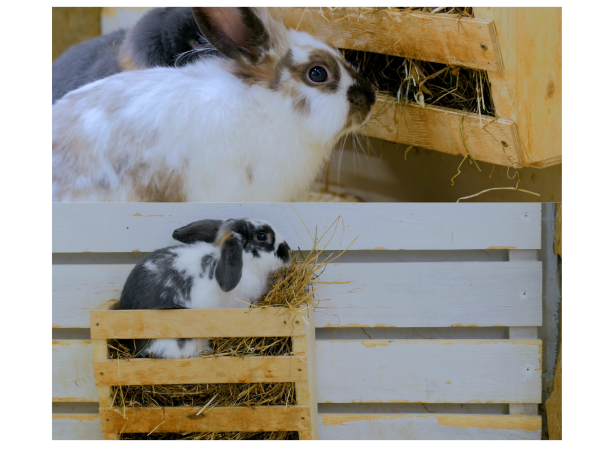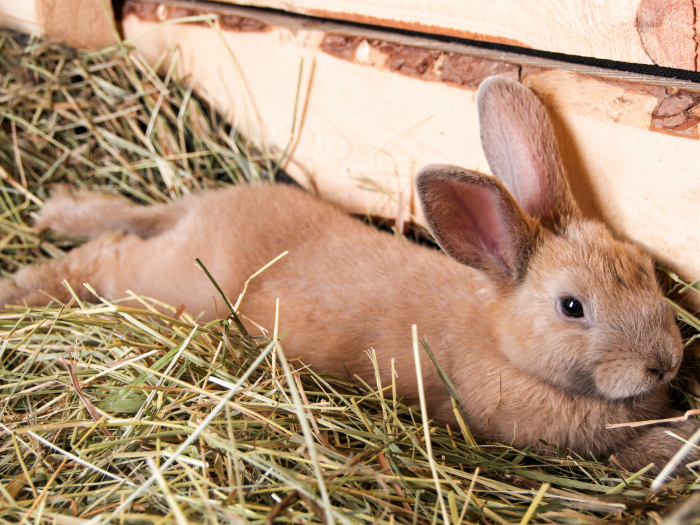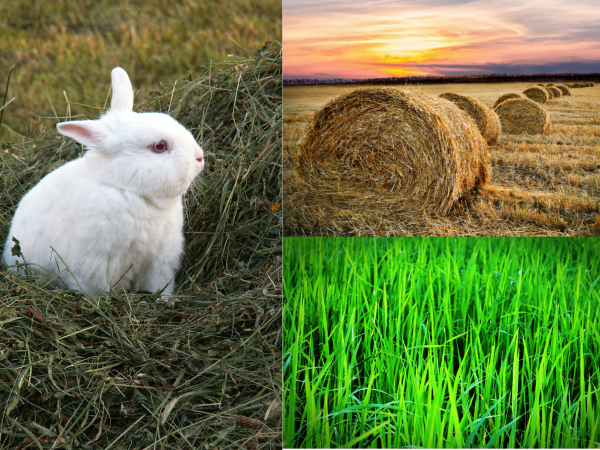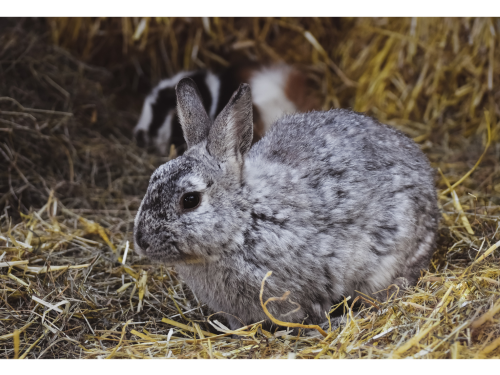How Much Hay Do Rabbits Eat?
You may want to know the answer to this common question for a school report about rabbits, or you because you saw several rabbits grazing the tall grass along the edge of your yard.
Either way, Hobby Farmers and homesteaders who are raising bunnies and feeding hay to rabbits want to know so they can calculate how much hay they need to buy, and transport, and put up in storage for their rabbits! And many new rabbit owners want to know the answer so they can feel more confident about how they are caring for their rabbit.
Fortunately, we have the answer and are ready to share it with you!
Can Rabbits Survive On Just Hay?
See the discussion below.
It is best to feed unlimited amounts of hay to our rabbits! That means rabbits can eat A LOT of hay!
- Feed a rabbit a nice thick bundle of hay about the size of the rabbit each day.
- On average, every day a healthy rabbit will eat a ball or “flake” of hay that is about as big as the rabbit.
- If all hay is eaten each day, then slightly increase the daily amount.
- If a little hay is leftover each day, then slightly decrease the amount of pellets and vegetables.
- If a lot of hay is leftover each day, then slightly decrease the amount of hay.
How Much Hay To Feed A Rabbit
Determining an amount of hay and measuring an amount of hay to feed your bunnies can be a bit tricky because it is such an essential food for healthy rabbits. In general, we want to always provide unlimited amounts of hay, but hay is expensive, so we also want to reduce wastage. It makes sense to understand how much hay our rabbit needs and be good stewards.
If measuring rabbit hay by volume, then much depends on how tightly packed the hay may be. You can loosely place a handful of hay in the hay feeder, or you can push on the hay and pack about 5 handfuls of hay into the hay feeder. That’s a big difference in the amount of hay.
Example: 5 lbs of hay is 5lbs of hay. Further, 5 lbs of loosely pack hay may fill a large laundry basket, or your kitchen trash can, or the entire trunk of your car. Whereas 5 lbs of tightly packed hay may be as large as a loaf of bread.
When measuring rabbit hay by weight, then amounts become much clearer. The problem is most of us do not have a nice scale conveniently hanging near our rabbit hutches.
That said, like so many things in life; once you measure out a standard amount of bunny hay several times, you become accustomed to what it feels like and looks like. For example, if you determine that you should feed 5 ounces of hay to your adult rabbit each day, then for several days you can measure out 5 ounces on your kitchen scale. By repeatedly measuring out 5 ounces, you will quickly become very adept at determining and judging how much is 5 ounces of hay, without the scale.

Adjust The Amount of Hay I Feed My Rabbit
More importantly, in addition to hay, you are also very likely feeding a measured amount of rabbit pellets and a measured amount of leafy green vegetables to your rabbit. You want to observe your rabbit’s eating habits over time and adjust the amount of hay, pellets and vegetables so that Hay is about 75 % to 80%, pellets are about 13% to 18% and mixed leafy green vegetables are about 7%, by weight, of your rabbits diet. By weight, meaning the proportional weights of hay vs pellets vs vegetables.
Here’s our advice explained in an example:
Let’s say we have an adult rabbit that weighs 4lbs. We will start by feeding this 4lbs bunny about 4 oz of quality hay per day, 1 oz of pellets, and ½ oz of mixed green leafy vegetables, by weight. Notice that this ratio by weight is 4 parts Hay to 1 part Pellets to ½ part vegetables… This is the equivalent of saying about 73% Hay, 18% Pellets and about 9% Vegetables (and some may argue that this is a tad high on the share of pellets!). Here’s what we do next to adjust and hone in on an appropriate hay feeding ratio for this rabbit.
- Provide the initial standard ratio of 4 hay to 1 pellet to ½ vegetables, by weight
- Observe – for a week don’t change any feeding amounts, just see how much of the food is eaten from day to day
- Begin to adjust – we begin to adjust based on our observations
- If hay is left over, then over several days we slightly decrease the number of pellets and green leafy vegetables until the hay is eaten
- We don’t want to decrease hay, hay drives the healthy rabbit digestive system
- If the hay is all eaten, then we slightly increase the amount and weight of hay, until there is left over hay
It is important to be are very patient with this process and to continue to observe the rabbit and periodically re-adjust the amounts you are feeding. The result will be the correct, balanced, healthy, primary diet ratio of hay, pellets, and vegetables for our rabbit. Rule of Thumb: Provide quality hay in unlimited quantity
How Much Hay Does A Rabbit Eat In A Month?
In a month a rabbit will eat about 150% of its weight in hay. The math on this is 5% of weigh per day x 30 days in a month = 150% of weight.
This is a rough rule of thumb to hep you estimate until you have experience with your specific rabbit.
Here is a helpful table for How Much Hay Does a Rabbit Eat In a Month?
| Rabbit Weight | Hay Per Month |
| 2 lbs or 907 grams | 3lbs or 1361 gram |
| 3 lbs or 1361 grams | 4.5lbs or 2041 grams |
| 4 lbs or 1820 grams | 6 lbs or 2722 grams |
| 5 lbs or 2268 grams | 7.5 lbs or 3403 grams |
| 6 lbs or 2722 grams | 9 lbs or 4082 grams |
| 7 lbs or 3175 grams | 10.5 lbs or 4763 grams |
| 8 lbs or 3629 grams | 12 lbs or 5443 grams |

How Many Pounds Of Hay Does A Rabbit Eat Per Day?
You can provide your rabbit with a good handful of hay that is about as big as the rabbit each day. This is a decent “rule of thumb” but is also a bit open to interpretation. As such, your rabbit will eat lots of hay every day! Another often spoken generality is that a healthy adult rabbit will eat about 5% of its body weight in hay each day.
Here is a Quick Reference Table: Feeding Ratios and Amounts for
Rabbit Body Weight to Hay Weight
| How Much Hay To Feed A Rabbit (Daily) | |||
| Target: Feed Hay at 5% of Rabbit Weight | |||
| Target Ratio | 4 | 1 | 0.5 |
| Rabbit Weight | Hay | Pellets | Veggies |
| 2 pounds | 1.6 oz | 0.4 oz | 0.2 oz |
| 910 grams | 46 g | 11 g | 6 g |
| 3 pounds | 2.4 oz | 2.4 oz | 0.3 oz |
| 1365 grams | 68 g | 17 g | 9 g |
| 4 pounds | 3.2 oz | 0.8 oz | 0.4 oz |
| 1820 grams | 91 g | 23 g | 11 g |
| 5 pounds | 4 oz | 1 oz | 0.5 oz |
| 2275 grams | 114 g | 28 g | 14 g |
| 6 pounds | 4.8 oz | 1.2 oz | 0.6 oz |
| 2730 grams | 137 g | 34 g | 17 g |
| 7 pounds | 5.6 oz | 1.4 oz | 0.7 oz |
| 3185 grams | 159 g | 40 g | 20 g |
| 8 pounds | 6.4 oz | 1.6 oz | 0.8 oz |
| 3640 grams | 182 g | 46 g | 23 g |
How Many Pounds Of Hay Does A Rabbit Eat Per Week?
To provide you with a rough guide, until you gain experience feeding hay to your specific rabbit, we offer the Daily Rabbit Hay Feeding Chart immediately above. Just multiply the daily amounts above by a factor of 7 to obtain the weekly amounts.
As an example, we see that a 5 lbs rabbit may eat about 4 oz of hay each day. So, on a weekly basis that is 4 oz times 7 days, equals 28 oz, or 1 pound 12 ounces, which is also 1.75 pounds of hay each day.
Again, these are guidelines to help you get started. Your observations of your rabbit will tell you much more and help you home in on your rabbit hay feeding routine.
How Much Timothy Hay For Rabbits?
Many people view timothy hay as the best hay for rabbits. They mention the high fiber, low protein and low calcium content of timothy hay and say that it is the best rabbit hay.
The fiber is the main ingredient that keeps the rabbit’s digestive system moving while the low protein and calcium is ideal for adult male rabbits and dry Does.
Now based on our personal experience, we have a more open view about hay. Our answer: With the exception of alfalfa hay, the primary rabbit hays such as timothy hay, orchard grass hay, meadow hay, and oat hay are similar from a nutritional point of view. Please see the Rabbit Hay Nutrition chart below.
We live in dairy county in south central Pennsylvania. Quite a bit of hay is made so we have the good fortune to be able to buy several types of rabbit hay directly from farmers and at a good hay market price.
If we find a good price on some quality Orchard grass hay, meadow hay, oat hay, or timothy hay, then we’ll likely buy it and happily feed it to our healthy rabbits. Additionally, we often feed a mix of rabbit hays. We view the diversity of hay as a healthy way to feed our rabbits.
Let’s take a closer look at the Hay nutrition table below

Rabbit Hay Nutrition Chart From House Rabbit Society
Below is a table of nutrients for the most popular bunny hays; adapted from House Rabbit Society.
Rabbit Hay Nutrition Table
| Hay | % Protein | % Fiber | % Calcium |
| Alfalfa | 15.3 | 27 | 1.4 |
| Barley | 4.0 | 38 | 0.3 |
| Meadow | 7 | 33 | 0.6 |
| Oat | 7.3 | 29.5 | 0.3 |
| Orchard | 9.8 | 30 | 0.3 |
| Rye | 7.4 | 26 | 0.5 |
| Timothy | 6.3 | 30.2 | 0.5 |
| Wheat | 7.4 | 25 | 0.2 |
Alphabetical order: popularity not implied by order. Relative outliers in this table include:
- Alfalfa hay for high its relatively high protein and calcium.
- Barley and Meadow hay stand out for their relatively high fiber content. Fiber is very important for rabbits. It is a primary ingredient that keeps the adult rabbit’s digestive system healthy and working properly.
- Here we see that the primary rabbit feed hays of Oat, orchard, Meadow and Timothy are very similar across the primary measures of Protein, Fiber and Calcium. Again the big outlier is Alfalfa hay.
How Much Alfalfa Hay To Feed A Rabbit?
When we are discussing nutritional value of rabbit hay and best hay to feed a rabbit, alfalfa hay is the strong outlier among the popular rabbit feed hays. Here are a few key points:
- Alfalfa has 2.4 times more protein than timothy Hay.
- Alfalfa has 10% less fiber than timothy hay but Alfalfa’s 27% fiber is still very good for rabbits.
- Alfalfa has 3.6 times more protein than timothy hay.
As we discussed in our post about Best Types Of Hay For Rabbits, alfalfa hay is excellent for pregnant and nursing mother rabbits, or Does, and also for weanling bunnies up trough age 6 months. Research at Michigan State University Extension has shown that pregnant and nursing Does, and their kits, do better when the Does have access to feeds that provide her with about a 16% protein level. The pregnant or nursing Doe is passing significant amounts of protein and calcium to her bunnies as they develop and rapidly grow bones and muscle.
Similarly, weaning bunnies (beginning at about seven weeks and then through to six months of age) need high protein and high calcium levels as they continue to rapidly grow their bones and muscle. Truth is, most owners will augment all types of hay with some quality rabbit pellets. A quality rabbit pellet is especially formulated to ensure that the rabbits are getting the right level of protein, vitamins, minerals and trace nutrients for health and longevity.
A dry Doe and a young buck 6 or more months old no longer need the high protein and high calcium. We recommend that dry Does and bucks over 6 months old be transitioned to a rabbit hay other than Alfalfa.

Will Rabbits Stop Eating When Full
Yes, most rabbits will stop eating, at least for a while. when they feel full or are satiated. When they stop eating, they will either rest or play for a while and then go back to munching on some hay.
It is said that a rabbit is more likely to feel full and satiated when it has a belly full of low carbohydrate, high fiber hay, rather than sugary treats. Rabbits seem to be continuously eating. Truth is, they are designed to be grazing periodically throughout the day and particularly in their most active times of low light, that’s morning and evening twilight.
Rabbits are crepuscular, they are not nocturnal. Being crepuscular means they are most active in both morning and evening twilight. Morning and evening twilight is when their primary predators such as foxes (diurnal or daytime predators) and owls (nocturnal or nighttime predators) are least active and have trouble seeing. So during mid day is when you may often find your rabbit resting more than eating.
Be aware that rabbits have a sweet tooth, so they are highly likely to overeat on treats… if they can find them or if they are fed treats. Please be mindful of this and limit how many treats you feed your rabbit!
Note that they need to eat a high fiber diet every day to keep their digestive system moving and functioning properly. A low fiber or fiber poor diet, likely higher in unnecessary carbohydrates and fat, may lead to GI Status. Fiber helps keep the rabbit from experiencing GI Stasis.
“Lack of fiber is the most common cause of gastrointestinal disturbance in the rabbit…. Breakdown of the normal physiological processes leads to disease.”
Frequently Asked Rabbit Hay Questions (FAQ)
Can Rabbit Survive on Just Hay?
It is feasible that rabbit may live off just hay and water. The question may be for how long and with what level of stress and relative health. We have no doubt that most rabbits will live a healthier and happier life if they are provided with a balanced diet of quality hay, augmented by quality rabbit pellets, and fresh, clean leafy green vegetables.
Can a Rabbit Have Too Much Hay?
No, if the rabbit has access to some quality pellets and some leafy green vegetables, then a rabbit can not have too much hay. To clarify a bit, if a rabbit only has access to hay, then even unlimited quality hay may not provide all the nutrients that your rabbit needs.
Should Baby Rabbits Have Unlimited Hay?
No baby rabbits don’t need hay, the best food for baby rabbits is their mother’s milk. Somewhere between 4 and 5 weeks of age, the baby rabbit begins to leave the nest for a few minutes several times a day, for a wander and to explore its environment. In doing this the baby rabbit will begin to find and eat some hay and some pellets. This is beneficial as it begins to wean the bunny and allows the bunny’s digestive system to slowly make the transition from mother’s milk to solid foods. When the young rabbit is eating more hay than mother’s milk, then it may have unlimited access to a quality alfalfa hay.
Final Thoughts For How Much Hay To Feed A Rabbit
As we’ve discussed, adult rabbits should have unlimited access to quality hay.
However, if concerned about wastage and putting out too much hay, then a general rule of thumb is to feed your rabbit about 5% of its body weight in quality hay each day. This likely amounts to a ball of hay about the size of the rabbit. You should always observe your rabbit’s eating habits and control their diet so that it is about 4 parts rabbit hay, to 1 part pellets, to ½ part leafy green vegetables.
Finally, alfalfa hay is ideal for pregnant and nursing Does and for newly weaned bunnies through to 6 months of age while timothy, orchard grass, oat hay, meadow hay are all great hays for dry Does and adult bucks.

